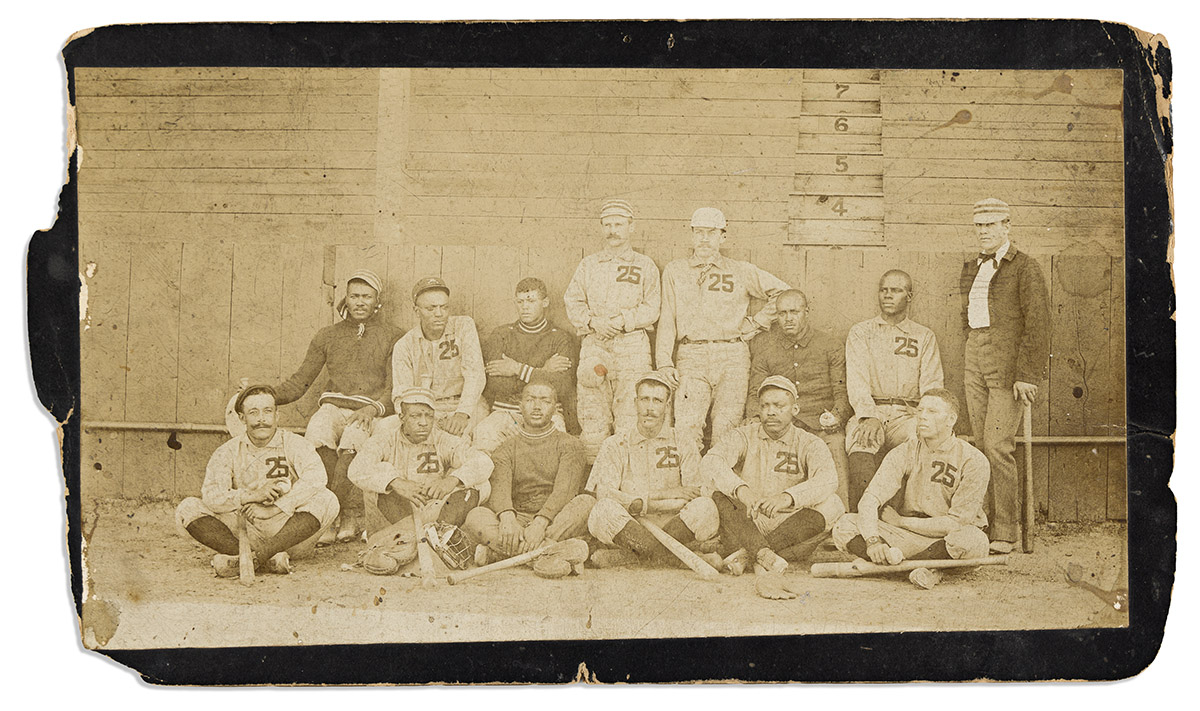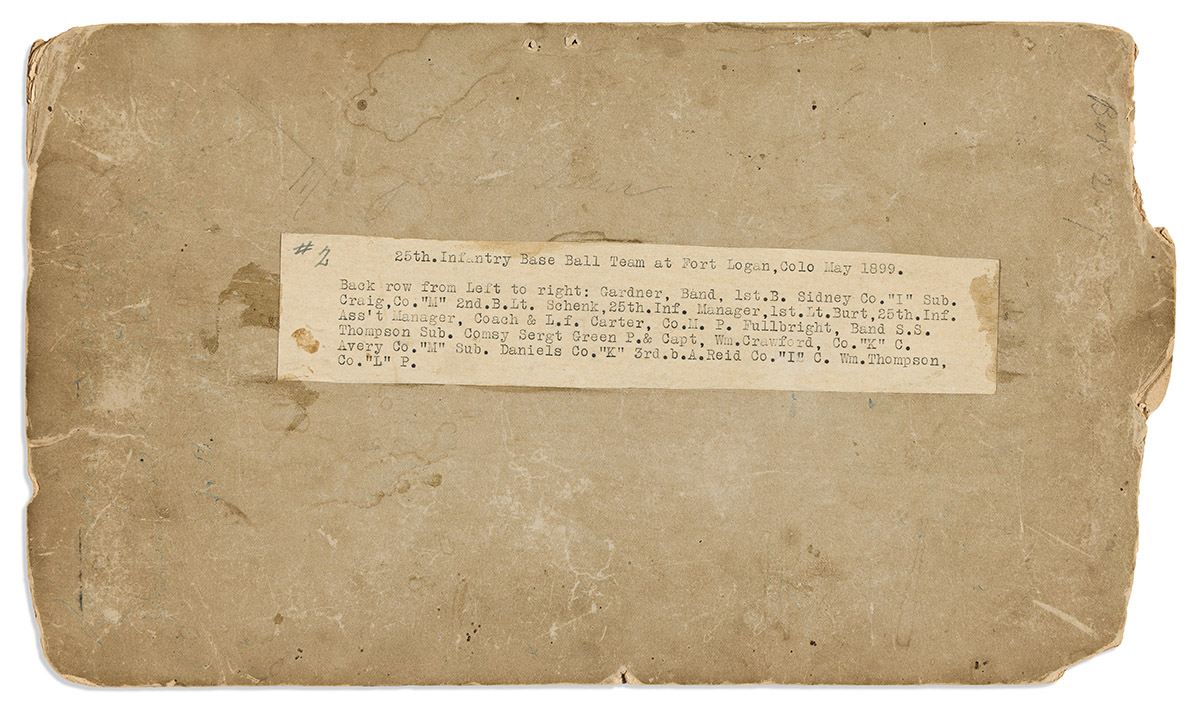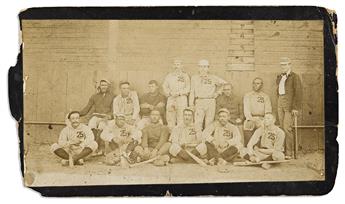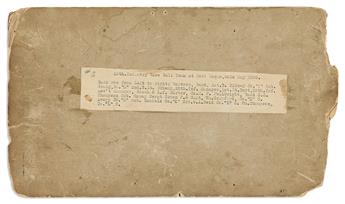Sale 2663 - Lot 430
Price Realized: $ 4,400
Price Realized: $ 5,500
?Final Price Realized includes Buyer’s Premium added to Hammer Price
Estimate: $ 4,000 - $ 6,000
(SPORTS--BASEBALL.) Photograph of famed baseball team of the 25th United States Infantry. Albumen photograph, 6¼ x 11¾ inches, on original plain mount, with typed key laid down on verso; mount edges chipped, moderate wear to image. Fort Logan, CO, May 1899
Show moreShow lessAdditional Details
This regimental baseball team was well on its way to becoming recognized as one of the best in the United States Army, and one of the great Black baseball teams in the years before the establishment of the organized Negro Leagues. Within a year, at least two of these players would be dead in the Philippines.
The 25th United States Infantry was one of the Army's four "Buffalo Soldier" regiments, also famous for its experimental Bicycle Corps which traveled hundreds of miles to deliver regimental mail from 1895 to 1898. They served with distinction in Cuba in 1898, were garrisoned in Colorado for part of 1899, and in June that year most of them were deployed to the Philippines to help suppress the independence movement.
The regiment's commander, Colonel Andrew Burt, launched the baseball team in 1894. From the beginning, the team's captain and pitcher was Sergeant Dalbert P. Green (seated, bottom left). They played against both white regiments and other Buffalo Soldier regiments. In Sergeant Green's telling, the team was regarded as the Philippine Island Champions from 1899 to 1902. The team later included future Negro League stars Dobie Moore and Hall of Famer Bullet Rogan, during the World War One era.
Adding to the interest of this photograph, it represents a semi-integrated team, with a white lieutenant serving as the left fielder and coach. Baseball had a few integrated professional teams through the 1880s and well into the 1890s, but by 1899 professional ball was completely segregated. The typed caption on verso names each of the players, their rank, their company, and their position on the ball field. Most of the players are, like Sergeant Green, Black enlisted men. Standing at center are 1st Lieutenant William Turner Schenk, the manager of the team; and 1st Lieutenant Reynolds Johnston Burt, the team's assistant manager, coach, and left fielder (Lieutenant Burt also happened to be the son of the regiment's commander Colonel Burt). Sergeant Green later recalled that Burt "rendered excellent service in imparting the West Point baseball strategy."
Here are the other team members, with some of their identities fleshed out with research in the regimental muster rolls and other sources: Corporal Nathaniel "Sandy" Gardner (1868-1955) of the regimental band, who played first base, and continued playing ball in Los Angeles after his 1899 discharge (top left); Private William Craig of Company M, the second baseman; Private William Carter of Company M, another pitcher (rear, third from right); Private William R. Fulbright of the regimental band, the shortstop, who later wrote a letter to the Indianapolis Freeman in 1901 on the progress of the war (rear, second from right); Thompson, the team's substitute (standing, rear right); Corporal William Crawford of Company K, who was Sergeant Green's catcher (front, second from left); Daniels of Company K, the somewhat light-skinned third baseman on the team, was apparently an enlisted man, either Sergeant Edward L. Daniels or Private Lewis A. Daniels (front, third from right); Corporal Augustus Reid of Company I, a catcher (front, second from right); and Quartermaster Sergeant William W. Thompson of Company L, a pitcher (front right). Like many baseball teams of this era, they had multiple pitchers and catchers, who would likely fill in the outfield spots when not in the battery. The three pitchers are all seen holding baseballs, and the catchers have their primitive gear at their feet, typical of baseball photographs of this era.
The regiment saw combat in the Philippines. Lieutenant Schenk, the team manager, was killed in action in January 1900 at Subic. Corporal William Crawford, one of the catchers in this photo, died the same month from wounds received in the line of duty--baseball duty. As Sergeant Green later recalled, during a game Crawford "had a small native dagger, or bolo, hung to his belt . . . and in the act of sliding to the base, the knife entered his abdomen. He lived for several days, but died eventually in the hospital at Angeles," in the Philippines. Sergeant Green went on to contribute a chapter on this baseball team to the 1927 regimental history, "History of the 25th Infantry Baseball Teams, 1894-1914," in "History of the Twenty-Fifth Regiment of United States Infantry, 1869-1926," 165-172. The present photograph is reproduced there on page 165; the book was reprinted in 2001. A reprint of the history is offered with this lot (and an original printing of the history can be found in lot 309). In 1995, Jerry Malloy, one of the leading historians of Negro League baseball, wrote an extensive article on the team, "The 25th Infantry Regiment Takes the Field," in "The National Pastime" 15.
With--an early photostat copy, 14¼ x 4¾ inches, of a newspaper clipping on the retirement of Sergeant Dalbert P. Green. The article originally appeared in the Honolulu Star-Bulletin of 6 September 1916.
And--11 photographs of Sergeant Dalbert Green, 1909, 1938 and undated
Show moreShow lessThe 25th United States Infantry was one of the Army's four "Buffalo Soldier" regiments, also famous for its experimental Bicycle Corps which traveled hundreds of miles to deliver regimental mail from 1895 to 1898. They served with distinction in Cuba in 1898, were garrisoned in Colorado for part of 1899, and in June that year most of them were deployed to the Philippines to help suppress the independence movement.
The regiment's commander, Colonel Andrew Burt, launched the baseball team in 1894. From the beginning, the team's captain and pitcher was Sergeant Dalbert P. Green (seated, bottom left). They played against both white regiments and other Buffalo Soldier regiments. In Sergeant Green's telling, the team was regarded as the Philippine Island Champions from 1899 to 1902. The team later included future Negro League stars Dobie Moore and Hall of Famer Bullet Rogan, during the World War One era.
Adding to the interest of this photograph, it represents a semi-integrated team, with a white lieutenant serving as the left fielder and coach. Baseball had a few integrated professional teams through the 1880s and well into the 1890s, but by 1899 professional ball was completely segregated. The typed caption on verso names each of the players, their rank, their company, and their position on the ball field. Most of the players are, like Sergeant Green, Black enlisted men. Standing at center are 1st Lieutenant William Turner Schenk, the manager of the team; and 1st Lieutenant Reynolds Johnston Burt, the team's assistant manager, coach, and left fielder (Lieutenant Burt also happened to be the son of the regiment's commander Colonel Burt). Sergeant Green later recalled that Burt "rendered excellent service in imparting the West Point baseball strategy."
Here are the other team members, with some of their identities fleshed out with research in the regimental muster rolls and other sources: Corporal Nathaniel "Sandy" Gardner (1868-1955) of the regimental band, who played first base, and continued playing ball in Los Angeles after his 1899 discharge (top left); Private William Craig of Company M, the second baseman; Private William Carter of Company M, another pitcher (rear, third from right); Private William R. Fulbright of the regimental band, the shortstop, who later wrote a letter to the Indianapolis Freeman in 1901 on the progress of the war (rear, second from right); Thompson, the team's substitute (standing, rear right); Corporal William Crawford of Company K, who was Sergeant Green's catcher (front, second from left); Daniels of Company K, the somewhat light-skinned third baseman on the team, was apparently an enlisted man, either Sergeant Edward L. Daniels or Private Lewis A. Daniels (front, third from right); Corporal Augustus Reid of Company I, a catcher (front, second from right); and Quartermaster Sergeant William W. Thompson of Company L, a pitcher (front right). Like many baseball teams of this era, they had multiple pitchers and catchers, who would likely fill in the outfield spots when not in the battery. The three pitchers are all seen holding baseballs, and the catchers have their primitive gear at their feet, typical of baseball photographs of this era.
The regiment saw combat in the Philippines. Lieutenant Schenk, the team manager, was killed in action in January 1900 at Subic. Corporal William Crawford, one of the catchers in this photo, died the same month from wounds received in the line of duty--baseball duty. As Sergeant Green later recalled, during a game Crawford "had a small native dagger, or bolo, hung to his belt . . . and in the act of sliding to the base, the knife entered his abdomen. He lived for several days, but died eventually in the hospital at Angeles," in the Philippines. Sergeant Green went on to contribute a chapter on this baseball team to the 1927 regimental history, "History of the 25th Infantry Baseball Teams, 1894-1914," in "History of the Twenty-Fifth Regiment of United States Infantry, 1869-1926," 165-172. The present photograph is reproduced there on page 165; the book was reprinted in 2001. A reprint of the history is offered with this lot (and an original printing of the history can be found in lot 309). In 1995, Jerry Malloy, one of the leading historians of Negro League baseball, wrote an extensive article on the team, "The 25th Infantry Regiment Takes the Field," in "The National Pastime" 15.
With--an early photostat copy, 14¼ x 4¾ inches, of a newspaper clipping on the retirement of Sergeant Dalbert P. Green. The article originally appeared in the Honolulu Star-Bulletin of 6 September 1916.
And--11 photographs of Sergeant Dalbert Green, 1909, 1938 and undated
Exhibition Hours
Exhibition Hours
Aliquam vulputate ornare congue. Vestibulum maximus, libero in placerat faucibus, risus nisl molestie massa, ut maximus metus lectus vel lorem.






